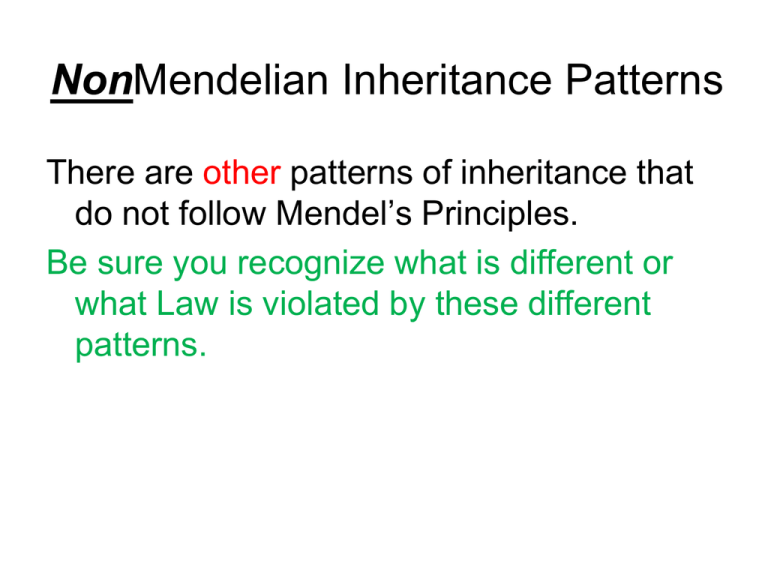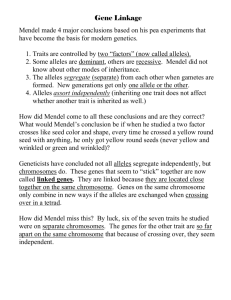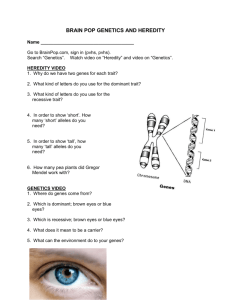NonMendelian Inheritance Patterns
advertisement

NonMendelian Inheritance Patterns There are other patterns of inheritance that do not follow Mendel’s Principles. Be sure you recognize what is different or what Law is violated by these different patterns. 1. Co-dominance Co-dominance=when two alleles are both expressed (neither masks the other) • Ex = human blood type • 3 different alleles (= versions of genes coding for one trait) include IA, IB, and i that code for A, B, and “o” blood types. NOTE: Positive or Negative is another trait and it follows Mendel’s Law of Dominance Blood Types (continued) • • • • Genotype Phenotype IAi or IAIA Type A blood IBi or IBIB Type B blood ii Type O Blood (the most common) IAIB Type AB blood (Co-dominant) Why are there different blood types anyway? • Because there is a connection between blood type and susceptibility to certain diseases. --AB nearly completely resistant to Vibrio cholera (a diarrheal) disease (European descent) --O slightly more resistant to malaria (African descent) 2. Incomplete Dominance • Also known as “blending” b/c neither allele in a pair is fully expressed • Example seen in Shorthorn Cattle C = color gene with alleles possible = CR (red), CW (white) • Cross a red bull with a white cow (Punnett Square) Shorthorn Cattle CRCW Roan Cattle 3. Linked genes = found on the same chromosome • Ex: the genes for petal shape & color are linked (C=curved or c=straight / W=white or w=blue); C & w are linked, c & W are linked. • Cross two heterozygotes (Punnett Square) • What Mendelian law do these results violate? Crossing over switches linked genes Read pp. 276-7 in text 4. Sex-linked Traits • Also known as “X-linked” • Mendel’s laws indicate that the parents’ gender should not matter. If you cross a purple flowered plant with a white flowered, it should not matter which is from the male pollen and which is from the female ovule. • Example 1 = eye color in fruit flies • Example 2 = Color blindness in humans / normal color seeing is dominant to color blindness but the gene that codes for this trait is linked (found on) to the X chromosome • X-C = normal color vision • X-c = color blindness • y (doesn’t code for color-seeing) What letter or number do you see? Light-sensitive opsin proteins made in the eye & needed for color vision are encoded by a cluster of genes on the X chromosome. Mutations in these genes can lead to an insensitivity to certain colors (like red and green) when seen together (“color vision deficiency”) • Cross a normal-seeing male with a carrier female. X-C y x X-C X-c • How does a colorblind male demonstrate NON-Mendelian inheritance? Hint: How many recessive alleles must an organism normally inherit to express a recessive trait? 5. Multiple Alleles (vs. just two) • Sometimes a trait is coded for by more than just two alleles • Example = human blood type has 3 alleles A, B, or O @ 9q34 = locus of where the gene is found 6. Polygenic Traits • More than one set of genes coding for a trait (NOT the same as multiple alleles) • Eye color is influenced by many genes coding for different kinds of pigment as well as where in the iris those pigments are found (some have been located on chromosomes 15 & 19) • Think of having 3+ colors from a crayon box and how much and in what order you mix them on a white page dictates the final color. • http://www.thetech.org/genetics/ask.php?id=203 7. Sex-influenced Traits • Aka, “Gender-influenced” • Usually influenced by sex hormones like estrogen, testosterone • Examples include baldness in humans, plumage in birds, horns on cattle 8. Environmentally-influenced • Color of the Hydrangea flower determined by the pH of the soil • Acidic soilblue flower • Basic soilpink flower • How about “intelligence” in humans? 9. Transposons (Jumping Genes) & Their Effect On The Kernel Color Of Indian Corn Grains of Indian corn come in different colors like purple or yellow. But what happens when they appear mottled/streaked? • This mottling effect defies Mendelian principles of genetics b/c individual grains may be multicolored rather than just one single color or another (purple vs. yellow). • The explanation? Involves "jumping genes" or transposons, and earned Dr. Barbara McClintock the Nobel Prize in Medicine (1983). 10. Genomic Imprinting • In recent years it has become apparent that the parental origin of genetic material does have an impact on gene expression and this effect has become known as genomic imprinting. • See http://epigenome.eu/en/2,5,126 on how ligers created by male lions mating with female tigers are much larger than tigons created by a male tiger with a female lion. Who’s your Daddy? • Imprinted genes are either expressed only from the allele inherited from the mother or in other instances from the allele inherited from the father. • Any examples of this in humans? Genomic Imprint of Chromosome #15 • Genetic deletion on the q arm of Chromosome #15 depends on whose chromosome you got it from. • If you got the deletion from Mom Angelman Syndrome • If you got it from Dad Prader-Willi Syndrome. • Angelman Absence of speech, mild to moderate mental retardation, small hands/feet, laugh a lot, dancing gait so called “Happy Puppet Syndrome.” • Prader-Willi Severe obesity, hyperactivity & severe mental retardation Review Get organized! Subtopic of Genetics = Patterns of Inheritance -- “How Do Characteristics Vary Within a Species?” Lab -- Notes of Mendelian Genetics incl. CH 11 -- Chapter 11 Homework Packet (4 pages) -- Notes on NonMendelian Genetics -- Passing on My Genes Simulation -- Testing Concepts + Spot Handout • Can you identify different described traits as following Mendelian or Non Mendelian inheritance? • Do you understand Mendel’s 3 Principles of Inheritance? • How do NonMendelian Patterns “violate” Mendelian genetics? • Can you do a monohybrid, dihybrid, or sex-linked cross? 1. Show the genotype of parents; 2. The resulting Punnett square; & 3. The Phenotypic Ratios








